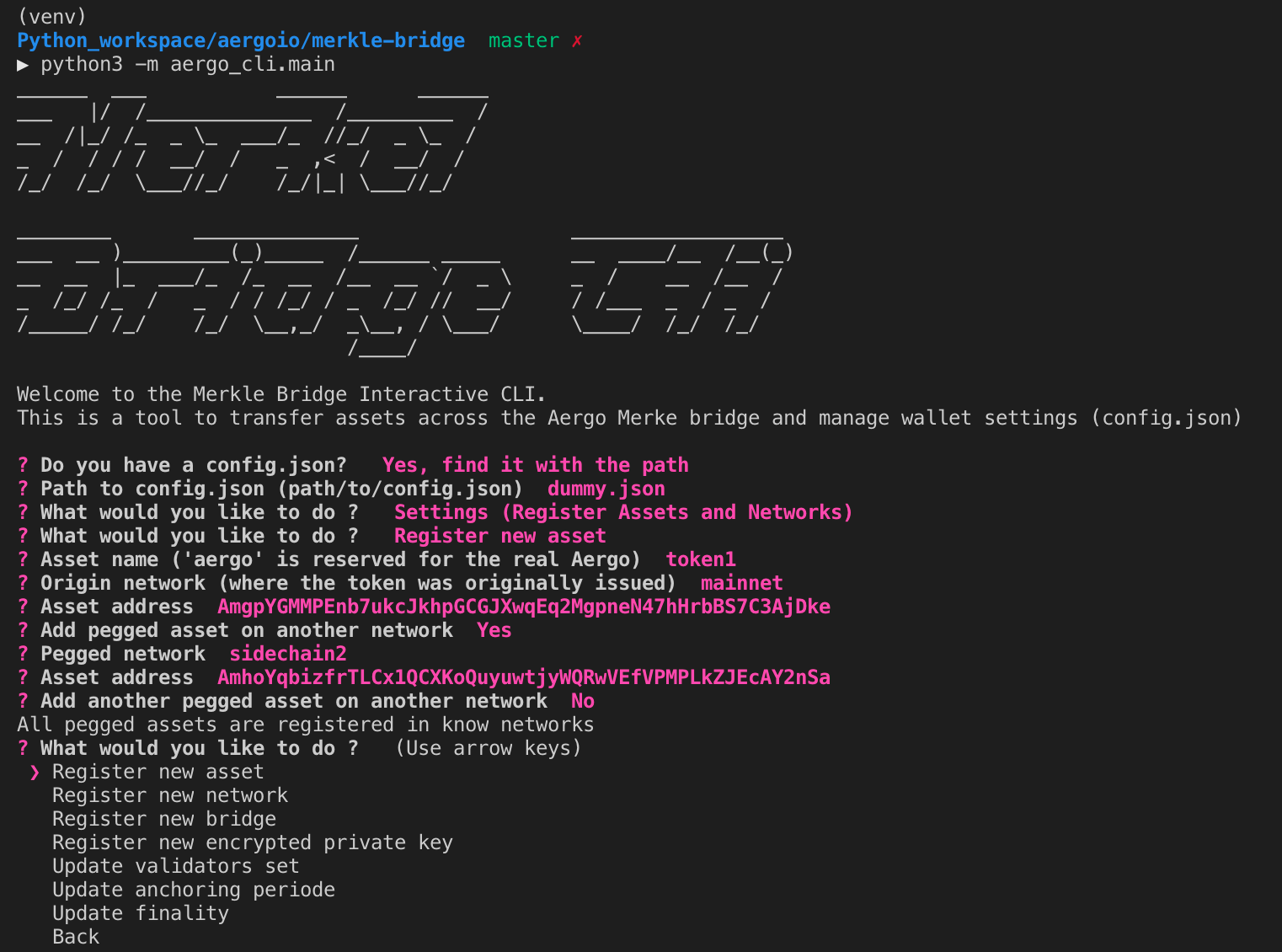Python wallet¶
The Python wallet can be used as a python command line tool for making simple transfers, bridge transfers, quering balances … The merkle-bridge/aergo_wallet repository can also be used as a module for other applications as the tools are separate and don’t need config.json to be used.
Create / Register a new account¶
from aergo_wallet.wallet import AergoWallet
# create a wallet
wallet = AergoWallet("./config.json")
# create a new account (new private key),
# you will be requested to create a password
# (DO NOT LOSE IT, it is the only way to decrypt your private key)
wallet.create_account("default")
# if you already have an exported private key (created by aergocli for example)
wallet.register_account('default', "exported_private_key", addr="Address_of_private_key")
Balance query¶
from aergo_wallet.wallet import AergoWallet
# create a wallet
wallet = AergoWallet("./config.json")
# get Aer balance of the default account on 'mainnet'
balance, _ = wallet.get_balance('aergo', 'mainnet')
# get Aer balance of Aer minted on 'sidechain2'
balance, _ = wallet.get_balance('aergo', 'sidechain2',
asset_origin_chain='mainnet')
Deploy a test token¶
from aergo_wallet.wallet import AergoWallet
# load the compiled bytecode
with open("./contracts/token_bytecode.txt", "r") as f:
bytecode = f.read()[:-1]
# create a wallet
wallet = AergoWallet("./config.json")
total_supply = 500*10**18
token_name = "my_token"
# deploy the token and store the address in config.json
wallet.deploy_token(bytecode, token_name, total_supply, "mainnet")
Register an already deployed token¶
This can be done with aergo_cli

or by editing config.json directly.
{
"tokens": {
"my_token": {
"addr": "AmgY8WARSNfjgCnFhFJBv145wkHJRTC7YR5MeJGAMvKzVD9kKeFz",
"pegs": {
"sidechain2": "AmheFWQf5decPrKZE1dnjh1EFwDq7qqAmobPbrUt4XeNK9QNCyxK"
}
}
}
}
or with the wallet:
from aergo_wallet.wallet import AergoWallet
# create a wallet
wallet = AergoWallet("./config.json")
" Register a 'mainnet' token and it's pegged self on 'sidechain2'
wallet.register_asset("my_token", "mainnet", "Address on mainnet",
pegged_chain_name="sidechain2",
addr_on_pegged_chain="Address on sidechain2")
Simple Transfers¶
from aergo_wallet.wallet import AergoWallet
# create a wallet
wallet = AergoWallet("./config.json")
# simple asset transfer on 'mainnet'
wallet.transfer(2*10**18, to_address, asset_name="my_token", network_name="mainnet")
# simple asset transfer of 'mainnet' assets pegged on 'sidechain'
wallet.transfer(2*10**18, to_address, asset_name="my_token", network_name="sidechain",
asset_origin_chain="mainnet")
Bridge Transfers¶
The bridge_transfer method calls transfer_to_sidechain or transfer_from_sidechain depending whether the token was minted or not.
from aergo_wallet.wallet import AergoWallet
# create a wallet
wallet = AergoWallet("./config.json")
amount = 1*10**18
asset = 'token1'
# transfer aergo from 'mainnet' to 'sidechain2'
wallet.bridge_transfer('mainnet',
'sidechain2',
asset,
amount)
The transfer_to_sidechain method performs the following:
- lock assets in the bridge contract
- wait for the next anchor on sidechain
- create a merkle proof of lock in the anchored state
- mint the asset on the sidechain with the merkle proof
The transfer_from_sidechain method performs the following:
- brun assets in the bridge contract
- wait for the next anchor on mainnet
- create a merkle proof of burn in the anchored state
- unlock the asset on the mainnet with the merkle proof
from aergo_wallet.wallet import AergoWallet
# create a wallet
wallet = AergoWallet("./config.json")
amount = 1*10**18
asset = 'token1'
# transfer aergo from 'mainnet' to 'sidechain2'
wallet.transfer_to_sidechain('mainnet',
'sidechain2',
asset,
amount)
# transfer minted aergo from sidechain2 mainnet
wallet.transfer_from_sidechain('sidechain2',
'mainnet',
asset,
amount)
It is also possible to perform the lock/burn and mint/unlock operations individually.
from aergo_wallet.wallet import AergoWallet
# create a wallet
wallet = AergoWallet("./config.json")
amount = 1*10**18
asset = 'token1'
# lock asset in the bridge contract to 'sidechain2'
lock_height, tx_hash = wallet.initiate_transfer_lock('mainnet', 'sidechain2',
asset, amount)
# lock more assets in the bridge contract to 'sidechain2'
lock_height, tx_hash = wallet.initiate_transfer_lock('mainnet', 'sidechain2',
asset, amount)
# get the amount of assets locked but not yet minted on 'sidechain2'
pending_mint = wallet.get_minteable_balance(
'mainnet', 'sidechain2', asset, pending=True
)
# mint the total balance of two previous locked amounts
pegged_address, tx_hash = wallet.finalize_transfer_mint(
'mainnet', 'sidechain2', asset, lock_height=lock_height
)
# Similarly,
# wallet.initiate_transfer_burn()
# wallet.get_unlockeable_balance()
# wallet.finalize_transfer_unlock()
# can be used to burn and unlock minted assets from a sidechain.
Using a Broadcaster¶
Deprecation WARNING : broadcaster functionality will be removed with next release.
When using a broadcaster to transfer tokens, the user pre-signs the nonce of a standard token transfer with a fee in tokens for the broadcaster. The broadcaster collects the token fee for executing the transactions, and the user doesn’t need to hold Aer in his wallet to make transfers. The broadcaster’s ip address should be registered in the wallet’s config.json
from aergo_wallet.wallet import AergoWallet
# create a wallet
wallet = AergoWallet("./config.json")
amount = 100*10**18
fee = 2*10**18
# the name of the asset should be same as the name registered in the standard token's
# Name state variable otherwise the broadcaster will say asset is not suported
asset = 'my_token'
# simple broadcasted transfer on 'mainnet'
wallet.d_transfer(amount, fee, to_address, asset, 'mainnet')
# simple broadcasted transfer of a 'mainnet' asset pegged on 'sidechain2'
wallet.d_transfer(amount, fee, to_address, asset, 'sidechain2',
asset_origin_chain='mainnet')
# Transfer asset from 'mainnet' to 'sidechain2'
# The broadcaster collects the asset fee on 'mainnet' and mints on 'sidechain2'
# Note : nothing actually forces the broadcaster to mint on sidechain.
# If the broadcaster is not nice and doesn't mint, users can use another broadcaster next time
wallet.d_bridge_transfer('mainnet', 'sidechain2', asset, amount, fee)
# Transfer asset from 'sidechain2' to 'mainnet'
wallet.d_bridge_transfer('sidechain2', 'mainnet', asset, amount, fee)
Wallet utils¶
If you wish to use the wallet as a module for other applications, the following tools are available:
- wallet_utils.py
- transfer_to_sidechain.py
- transfer_from_sidechain.py
- token_deployer.py
You will need to connect your own herapy instances to nodes and load your private key in herapy.